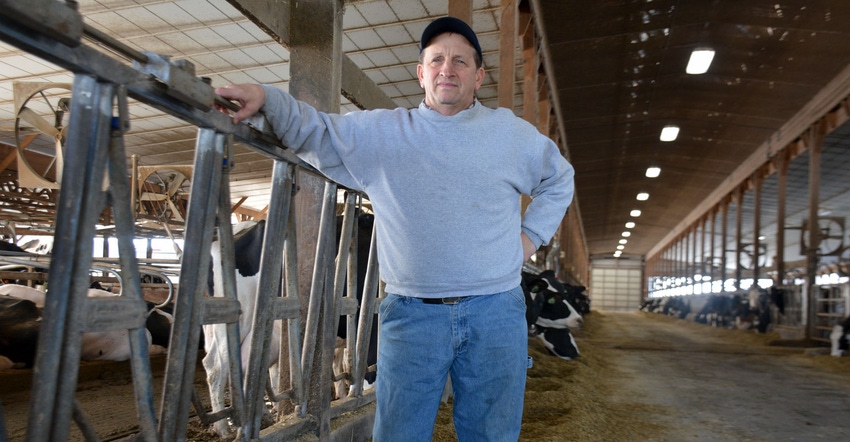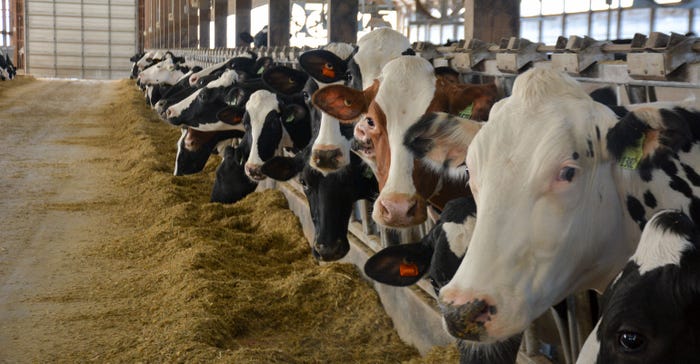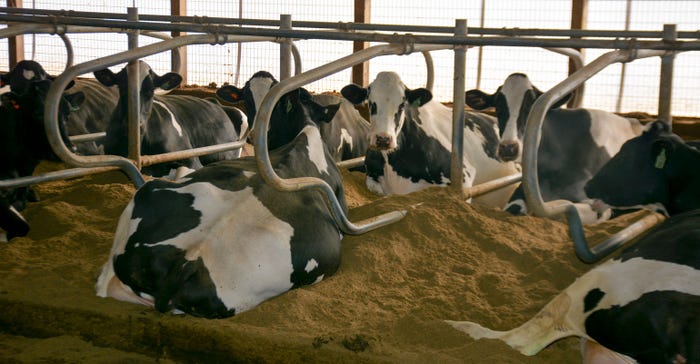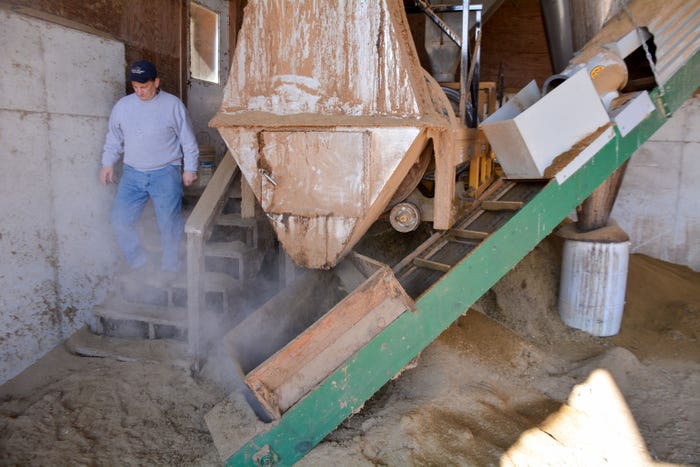
For anyone wanting to get into the dairy business, Pennsylvania dairy farmer Reid Hoover has some advice.
“You got to take care of details from the day the calf's born,” Hoover says. “Everything matters, you got to be willing to do your best job. Details are critical. You see a heifer sick today you treat her today, you don’t wait until you have time.”
It’s this commitment to details and cow care that has kept Hoover, owner of Brook-Corner Holsteins, in business, even during the darkest times for dairy farmers.
His family has been farming in Lebanon County since the mid-1960s when his father, originally from Lancaster County, moved to Lebanon County in search of cheaper land. Hoover was only 4 years old at the time.
The youngest of four siblings, he took over the farm from his father in 1983 after going to college in Kansas for two years for agribusiness. His oldest brother has a dairy farm nearby, while another brother joined Hoover on the home farm before leaving for another career. An older sister is not involved in the farming operation.
Sharing responsibilities
While Hoover and his son, Brad, milk 370 cows — they have another 300 heifers and young stock — and farm 120 acres on the home farm, he co-manages 650 acres of land with his brother. Hoover’s wife, Diane, handles most of the farm’s calf care.
Hoover says the arrangement is better for cash flow as he and his brother can share equipment and the responsibilities of the land while dairy farming separately. They have formed a limited partnership.
Most of the crops grown are corn silage with a little bit of corn shelling done, too. This year was the first year that he didn’t grow alfalfa, so he’s become dependent on rye and triticale in the spring before silage gets planted.
Brown midrib hybrids are something he’s tried in the past, but with only limited success. He says that he might try BMRs again in 2020.
 MORE ROOM: The farm’s free-stall barn was built in 2012. It provided a new center alleyway for easy feeding, sprinklers and fans for cow comfort, and other amenities to improve herd health.
MORE ROOM: The farm’s free-stall barn was built in 2012. It provided a new center alleyway for easy feeding, sprinklers and fans for cow comfort, and other amenities to improve herd health.

With co-managing 650 acres, Hoover says it provides nearly all the feed his cows need short of hay, which they must buy in, and a little bit of corn.
Focus on cow comfort
By the 2000s the 60-cow tie-stall setup was getting cramped and cow comfort was suffering.
Up to 130 cows were being milked in the tie-stall barn.
With Brad, wanting to return to the farm, conversations around expansion started. Then came 2009, when dairy prices tanked. It wasn’t easy for Hoover and his family as they were barely trying to survive.
Even so, they started looking at expansion options, seeing where they wanted to be in five to 10 years.
After visiting several other dairy farms and getting their financials and permits in order, the shovels were put in the ground in 2011. At the same time, the herd was starting to be expanded in anticipation of the larger facilities.
“We knew what he had,” Hoover says. “That’s when we said, ‘Let’s start keeping our heifers and try to work the numbers up,’ so we did not have to bring some in from the outside.”
But the overcrowding situation got worse before it got better. Up to 200 cows were being milked in the tie-stall barn as the new free-stall facility was being built.
Summertime was the worst. With the lack of modern cow comfort facilities, Hoover says they lost up to 10 pounds in milk production per cow during the hottest days of the year.
“That was nuts,” he says. “We had cows everywhere. We joke about it now, but it was stressful.”
 MANURE BEDDING: Hoover originally wanted to bed with sand, but he opted for bedded manure as it was the cheaper option.
MANURE BEDDING: Hoover originally wanted to bed with sand, but he opted for bedded manure as it was the cheaper option.

Finally, in 2012, the new free-stall barn was finished. A double-12 milking parlor was also built.
Hoover and his family brought in a dairy profit team through the state’s Center for Dairy Excellence to help during the expansion. The team included an outside facilitator, a veterinarian, Extension personnel and others who helped guide the family through the expansion.
While much of his mind was made up about what he wanted to do with the expansion, Hoover says the team provided some good feedback on cow comfort issues as well as the idea of putting in a bunk silo instead of feed bags, which he originally wanted to do.
Even though it cost more up front to put in the bunk silos, the result has been better, more consistent feed. He put in two bunk silos.
“You can get awfully good feed out of bunkers,” he says. “This was the biggest thing that came out of there.”
The new free-stall barn includes brand new sprinklers, fans and automated curtains. Hoover says he likes the facility because it gives him room to separate yearlings and aged cows, or ones that are sick and need more attention.
A new synthetic-lined earthen manure pit was also built. The 2.5-million-gallon pit provides enough storage for six months. The old manure pit is used for dry cows.
New barn, new issues
As the expansion was being planned, Hoover thought he would go with sand bedding and sand lanes to improve cow comfort. But with the number of cows he had, he found that it wasn’t cash-flowing enough for him to use sand.
Instead, he and Brad decided to put in a manure separator and bed with manure solids.
Lots of farms use manure solids for bedding and it worked for Hoover for a little while.
“But manure is manure,” he says, and the cows started having health problems with high somatic cell counts and a potentially deadly form of mastitis.
“We were treating lots of cows. That was one area that we were really frustrated with,” he says.
A local company that roasted corn and soybeans suggested the farm become the “guinea pig” for a roasted manure treatment they were experimenting with.
Hoover says he was hesitant at first, given the risks. He wanted some assurances that he wouldn’t be on the hook if the system didn’t perform as well as advertised or if it failed.
After negotiating with the company, the manure roasting system was put in. Attached to the separator, the system heats up manure to 160 degrees. The idea is that by roasting the dry manure, the process will kill harmful bacteria that leads to mastitis.
 SEPARATING AND ROASTING: A roaster attached to the manure separator heats up the dry manure to 160 degrees to kill any harmful bacteria. Hoover says the machine has helped reduce cases of mastitis as well as somatic cell counts.
SEPARATING AND ROASTING: A roaster attached to the manure separator heats up the dry manure to 160 degrees to kill any harmful bacteria. Hoover says the machine has helped reduce cases of mastitis as well as somatic cell counts.

So, did it work? The results, at least thus far, have been very good.
“It made life a lot better,” Hoover says.
Somatic cell counts dropped from a high of 300,000 to below 200,000 with the roaster installed. Even more important, mastitis cases have dropped dramatically and he’s treating a lot less cows.
As he beds the stalls four times a week, the system runs four times a week when the separator is operating. It takes about five hours during those days to provide enough bedding for the stalls.
“It’s been a learning experience, but we like it,” he says.
Not out of the woods
Even in this tough ag economy, Hoover keeps a positive attitude. Maybe it’s the good prices, as 2019 has been much better than 2018, which he called “brutal.”
“This year has been better but not great. A big hole was dug in ’18 and it will take a while to pull out of it,” he says.
There is also the prospect of the Dean Foods bankruptcy. Hoover ships his milk to the local Swiss Premium plant, which Dean owns. It’s something that he’s keeping a close eye on as whatever happens during the bankruptcy will affect his farm directly.
The rolling herd average is 28,000 pounds, not quite where Hoover wants the herd to be but not bad either.
And even with the expansion, he still has some overcrowding issues as there are a lot of heifers on the farm right now.
As prices have improved, Hoover says he’s focused on paying down some debt and staying within his means. The debt from the expansion will take several more years to pay off.
“I’m still glad we did it, but it’s a struggle. Sometimes I think if we didn’t do it we wouldn’t have the debt, but we wouldn’t have the good facilities either, and the cow comfort was not good,” he says.
So, he’s counting his blessings for better days ahead.
“I’m a positive guy. I have a lot to be thankful for,” Hoover says.
About the Author(s)
You May Also Like






